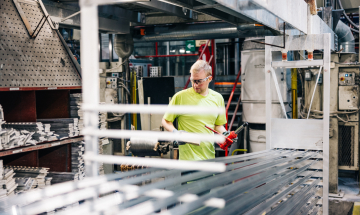The Federation requests decisions: Continuous uncertainty will not attract investments
It is vital that the Finnish economy return to a growth path. The CEO of the Federation of Finnish Technology Industries Jorma Turunen emphasises that it is important that the government finds some leeway by introducing sensible structural solutions to counterbalance the weakness of Finland’s public economy.
“Bold structural changes should be counterbalanced by investments into the future. Investments need a predictable operating environment, which requires continued resistance to any attempt to make decisions that endanger industry competitiveness,” Turunen points out.
Labour market organisations continue their negotiations over the social contract. Finland’s price and cost competitiveness lags 18 per cent behind that of our key competitors. It is of vital importance to conclude the negotiations with the agreement to improve the cost competitiveness of Finnish labour by five per cent. The negotiators need to stick to this ambitious goal.
“The union-specific negotiations in the autumn will aim to seek an export-driven salary solution and another five per cent improvement,” Turunen says. The remainder will be made up by improved productivity of companies.
Technology industry order books continue to improve slightly
The turnover of technology industry companies in Finland grew slightly in 2015, totalling almost EUR 68 billion. This is almost EUR 20 billion short of the pre-recession level of 2008.
The companies that took part in the Federation of Finnish Technology Industries' survey of order books reported that the monetary value of new orders between October and December was eight per cent lower than in the corresponding period in 2014, but two per cent higher than in the preceding quarter. Of the respondents, 62 per cent reported a higher number of new orders compared to July-September, 28 per cent said that order volumes had fallen and 10 per cent said that the orders had remained stable.
At the end of December, the value of order books was up 15 per cent from the corresponding period last year, and three per cent higher than at the end of September. Forty-six per cent of companies reported a decrease in the number of orders from September, while 41 per cent reported an increase and 13 per cent had seen no change.
“Judging from the order trends in recent months, the turnover of technology industry companies is expected to remain at the same or a slightly lower level in early 2016 than in the corresponding period last year,” Jorma Turunen says.
In 2015, the number of personnel employed by Finnish technology industry companies fell by almost one per cent or 3,000 employees. Personnel numbers also fell in the period between October and December. At the end of December, 17,000 employees were affected by temporary or part-time lay-offs. On average, the industry employed 282,000 people in 2015. In 2008, the industry employed a total of 326,000 people in Finland.
Expertise creates success
Technology industry companies recruited a total of 28,500 new employees last year, 6,200 of which in October–December.
“Expertise is of great importance for our industry. Technology industry is responsible for three quarters of all private-sector R&D investments in Finland. There is fruitful cooperation between businesses, universities and research institutes,” says Sanna Rauhansalo, Head of Unit at the Federation of Finnish Technology Industries.
She is concerned over the reduced level of public-sector investment into research and development.
“Reports on the use of funding, such as funding through Tekes, indicate that the ROI has been good. Cuts should be avoided in areas that have a direct impact on our future success,” she emphasises.
Pursuant to its decision in 2015, the Federation of Finnish Technology Industries donated a further EUR 11 million to universities, in addition to the previous donation of EUR 140 million.
“The main criteria of our donation is to ensure top technological expertise, help universities develop a more distinctive profile and support their strategic cooperation with businesses. We hope this will encourage others to take measures that promote growth and renewal in Finland,” Rauhansalo says.
The Finnish vocational training system is also undergoing structural changes. It is of central importance to take into consideration the competency requirements of businesses and the export sector in particular.
“Vocational training should focus on expertise that is in demand, and this is determined by businesses,” Rauhansalo points out.
Politicians should resist the temptation to introduce their own agendas when establishing autonomous regions. It is important to remember that labour markets are not regional and that state funding should be allocated directly to the training providers.
Further information:
Jorma Turunen, CEO, tel.+358 500 445 444
Sanna Rauhansalo, Head of Unit, Industrial Policy, tel. +358 50 340 6174
Jukka Palokangas, Chief Economist, tel. +358 40 750 5469
firstname.lastname@teknologiateollisuus.fi


